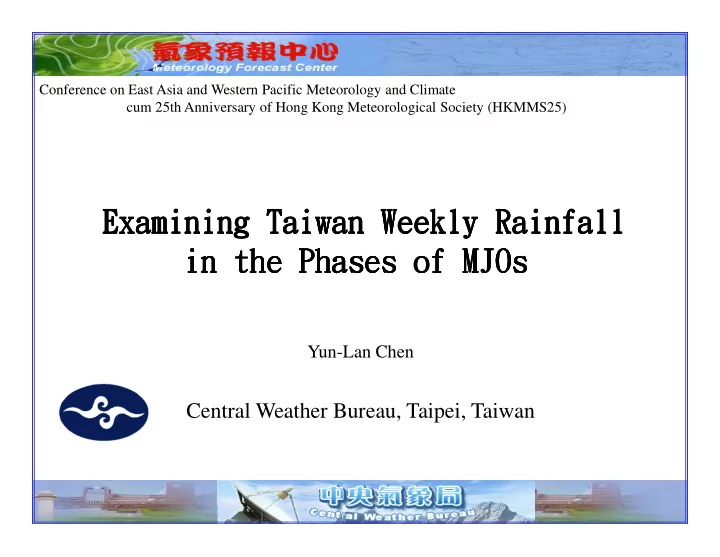

Conference on East Asia and Western Pacific Meteorology and Climate cum 25th Anniversary of Hong Kong Meteorological Society (HKMMS25) Examining Taiwan Weekly Rainfall Examining Taiwan Weekly Rainfall Examining Taiwan Weekly Rainfall Examining Taiwan Weekly Rainfall in in in in the Phases of MJOs the Phases of MJOs the Phases of MJOs the Phases of MJOs Yun-Lan Chen Central Weather Bureau, Taipei, Taiwan
RMM index ( Wheeler and Hendon , 2004 ) : An objectively-defined index to monitor and predict variations related to the MJO RMM1 RMM2 Phase Amplitude
RMM index applications : ( CHEN, 2004, CWB internal website)
Helping monitoring on Monsoon and Tropical cyclone activities
Understanding the possible influence on local weather/climate Probabilities of abnormal weekly rainfall in Taiwan in the 8 phases of the RMM index Excess rainfall : weekly rainfall > 70% historical ranking RMM index amplitude > 1.0 Statistics base on 1979 ~ 2012 Low prob. High prob.
Are there different types in a same MJO phase ? Take FMA for example Focus on Phase 4 OLR(Ano) & W850(Ano) composite by RMM index OLR Ano(-) OLR Ano(+) Low prob. High prob. Phase 4 ( cases dry in Taiwan) Phase 4 ( cases wet in Taiwan)
Can we sift the information for a better local forecast application ? Maybe a bottom up strategy would do….. EX : For a specific MJO phase, 1. Distinguish the key differences by Taiwan wet/dry cases 2. Categorize the phase by conditions favor local wetness
1. Distinguish the key differences by Taiwan wet/dry cases Cases DRY in Taiwan Cases WET in Taiwan Lag 16~20 days Lag 11~15 days Lag 6~10 days Lag 0 Phase 4 � � The difference over Philippines to M.C. is evident at lag days. � �
2. Categorize the phase by conditions favor local wetness ( In this case, OLR over Phillippines to M.C. is significant positive at lag days. ) Prob. of wet ness from type A Phase 4 data samples. Type A 14-day Trajectory The probabilities have Lag 6~10 days increased to over 40%, some reach to 50%. Phase 4 P4 (A) Type A (positive aolr at lag days) Divided to two types Type B ( Others ) P4 (B) Type B 14-day Trajectory Lag 6~10 days � � Not all MJO phase 4s follow by a earlier strong anticyclonic high over Phillippines to M.C. area. � � For those do, Taiwan will have more chances to get wet than the other type, which also imply there are different predictabilities for Taiwan rainfall in the two MJO types.
Summary � RMM index is capable of capturing the tropical large scale eastward propagating waves, as well as the northward. It has been well adapted in many operation centers as an important index for monitoring and forecasting the sub-seasonal climate variations. The index has also been one of the form that routinely output from the numerical forecast models. It will be with practical values to check how local key weather elements change with the phase of MJO index. � The statistical result of the probabilities of wetness in Taiwan during each MJO phase shows difference in seasons. Islandwide excess rainfall in the winter and spring seasons tend to happen when the tropical convections still sit on Indian ocean(before phase 4), while when moving to warm seasons, in which the weathers in Taiwan are more dominated by SW monsoon and the northwestern Pacific tropical convection systems, wet situations are relatively more seen after phase 5 . � Even only the cases with RMM amplitude greater than 1 were selected in this study, the composite maps and the statistics for the same specific phase may come from different type of MJOs. Some differences , although still catch the large scale MJO phase major pattern, might bring opposite changes to local weathers. � This study take FMA season for example, using the bottom up strategy, dividing the MJOs to 2 group according to the key features that distinguish wet or dry conditions in Taiwan. The result shows an earlier strong anticyclonic system over Philippines to M.C. area is an important sign that tend to bring Taiwan abundant rainfall later. � Further examining the two groups of phase 4 cases, it reveals the type B have more strong La Nina events. It might be the reason that the earlier strong anticyclone, which is usually seen before phase 4 , is suppressed by the more active western Pacific convections during La Nina years. This also suggests the forecast information interpreted from MJOs should not be all taken as the same. � Forecasters might need to distinguish the key air-sea features that affect the local weathers, and also do researches to get its robustness or variations associated with the MJO cycle. We might need to try not just relying on the MJO cycle prediction information, but should also monitoring carefully the potential precursor to do a better judgment for the forecast.
氣象局 預報中心 陳雲蘭 e-mail : yunlan.chen@mfc.cwb.gov.tw
DJF (Phase 3)
MJ (phase 6)
JAS (phase 6)
Recommend
More recommend